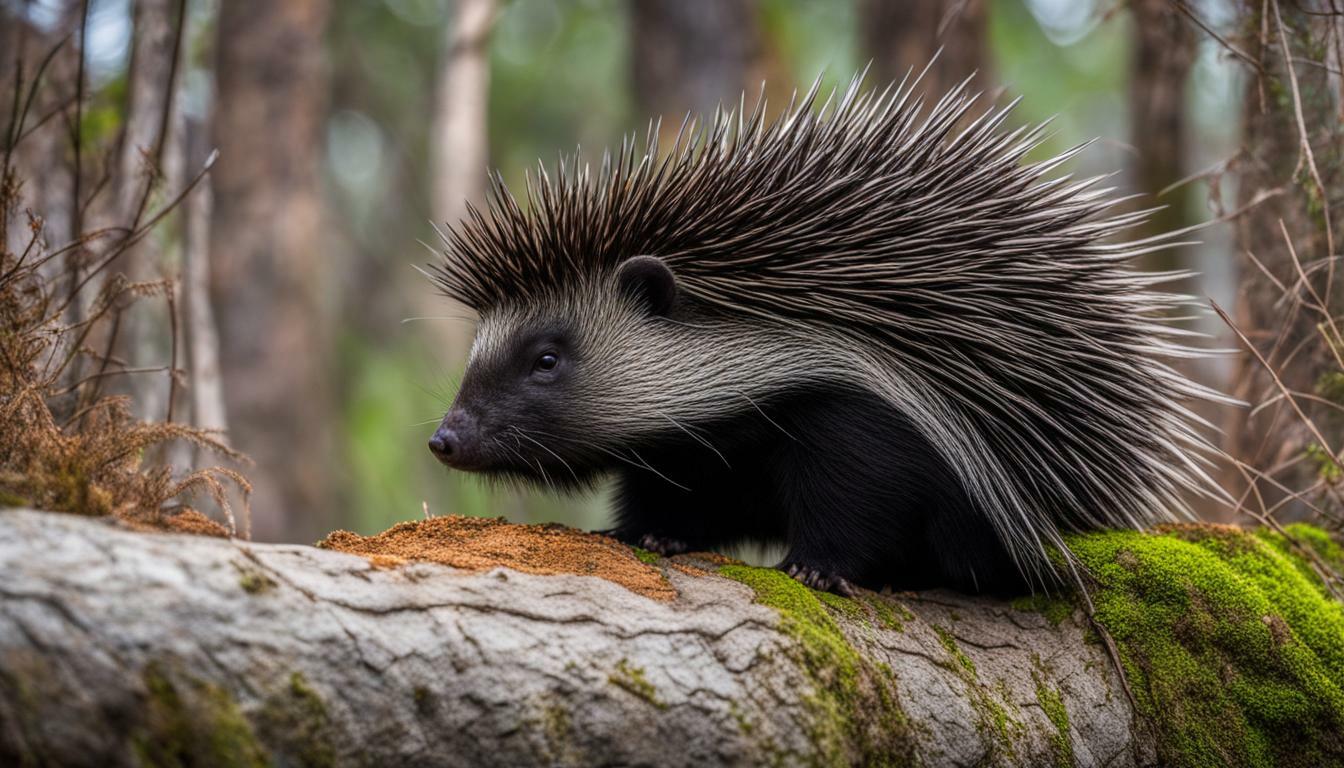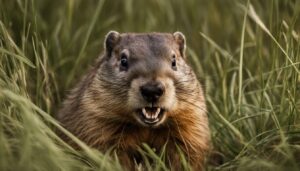Porcupines in Michigan: Habitat and Behavior
Porcupines in Michigan can be found in various habitats, particularly in areas with dense forests. These fascinating creatures are known for their unique appearance, with a coat of sharp quills covering their body as a defense mechanism against predators.
Typically measuring 2-3 feet long and weighing around 8-15 pounds, with some reaching up to 40 pounds, Michigan porcupines are herbivores. Their diet varies throughout the year, with a preference for fruit, leaves, buds, acorns, and beechnuts. In order to access the cambium, they may also chew through tree bark, which can lead to damage to trees.
Porcupines are primarily nocturnal animals, meaning they are most active during the night. They are solitary creatures, except during the winter months when some porcupines may den together for warmth. Unlike some other animals, porcupines do not hibernate or migrate.
| Physical Characteristics | Behavior |
|---|---|
| Porcupines are covered in sharp quills for protection. | They are primarily nocturnal and solitary. |
| They measure 2-3 feet in length and weigh 8-15 pounds. | During winter, some porcupines may den together for warmth. |
| Porcupines have a varied diet, including fruit, leaves, buds, acorns, etc. | They do not hibernate or migrate. |
While porcupines can be fascinating to observe, they can also be a nuisance. They may chew on exposed wood, including houses and sheds, causing damage. To minimize porcupine problems, it is advised to remove artificial food sources, secure garbage can lids, enclose compost piles, and protect vulnerable crops and ornamental plants.
In Michigan, porcupines are not protected and can be hunted year-round with a valid hunting license. However, it is important to exercise caution when encountering a porcupine, as their quills can cause injury and infection. It is best to avoid contact and appreciate these unique creatures from a safe distance.
Porcupine Species in Michigan
Michigan is home to two species of porcupines – the North American porcupine and the Canadian porcupine. These fascinating creatures can be found in various areas of the state, particularly in regions with dense forests.
The North American porcupine (Erethizon dorsatum) is the more common species in Michigan. They are usually 2-3 feet long and weigh around 8-15 pounds, although some individuals can reach up to 40 pounds in weight. These porcupines have a stocky body covered in sharp quills, which serve as their primary defense mechanism against predators.
The Canadian porcupine (Erethizon canadense) is less frequently encountered in Michigan. They are similar in size and appearance to the North American porcupines, with a dense coat of quills and a robust body. Both species are nocturnal and primarily herbivorous, feeding on a variety of plant materials such as leaves, fruits, buds, acorns, and beechnuts. They are even known to chew through tree bark to reach the cambium layer.
| Species | Size | Weight | Diet |
|---|---|---|---|
| North American porcupine | 2-3 feet | 8-15 pounds (up to 40 pounds) | Fruits, leaves, buds, acorns, beechnuts, tree bark |
| Canadian porcupine | 2-3 feet | 8-15 pounds (up to 40 pounds) | Fruits, leaves, buds, acorns, beechnuts, tree bark |
Porcupines in Michigan are solitary animals, except during the winter months when some may den together to conserve heat. Unlike many other wildlife species, porcupines do not hibernate or migrate. They can cause damage to trees by chewing on bark, and they may also pose a nuisance by gnawing on exposed wood, including buildings and sheds.
It is important to note that porcupines are not protected in Michigan, and they can be taken year-round with a valid hunting license. However, when encountering a porcupine in the wild, it is advised to avoid contact as their quills can cause injury and infection. Proper preventive measures are also recommended to minimize porcupine problems, including the removal of artificial food sources, securing garbage can lids, enclosing compost piles, and protecting vulnerable crops and ornamental plants.
Physical Characteristics of Porcupines
Porcupines in Michigan typically measure around 2-3 feet in length and weigh between 8-15 pounds. However, some individuals can reach weights of up to 40 pounds. These herbivorous rodents have a stout body covered in sharp quills, which are modified hairs made of keratin. Unlike popular belief, porcupines cannot shoot their quills, but when threatened, they will raise their quills as a defense mechanism. These quills serve as a deterrent to predators and can cause injury upon contact.
Their quills are their most distinctive feature, with an average porcupine having about 30,000 quills on its body. These quills are typically 2-4 inches long and are covered in barbs or microscopic backward-facing hooks that make them difficult to remove once embedded. The quills are also detachable, allowing porcupines to lose a few if they come into contact with a predator or threat. The quills are replaced over time, growing back to full length.
Porcupines have short legs with sharp claws that enable them to climb trees and grip onto branches. Their sharp incisors are perfect for gnawing on bark, branches, and vegetation. They have a stocky build, with a small head and small eyes. Their senses of hearing and smell are well-developed, compensating for their relatively weak eyesight.
Table 1: Physical Characteristics of Porcupines
| Characteristic | Description |
|---|---|
| Size | 2-3 feet in length |
| Weight | 8-15 pounds, up to 40 pounds |
| Quills | 30,000+ quills, 2-4 inches long, barbed |
| Limbs and Claws | Short legs with sharp claws for climbing |
| Head | Small head with small eyes |
Porcupines in Michigan have unique physical characteristics that enable them to adapt to their environment and protect themselves from predators. Their quills are a key defense mechanism and an iconic feature of these fascinating creatures.
Porcupine Diet and Feeding Habits
Porcupines in Michigan are herbivores and their diet varies depending on the time of year. These fascinating creatures primarily consume a wide range of plant material found in their habitat, including fruit, leaves, buds, acorns, beechnuts, and tree bark. Their ability to chew through tree bark is particularly impressive, as they use their strong teeth to access the cambium layer beneath, which provides essential nutrients.
Throughout the warmer months, porcupines feast on the abundance of fresh vegetation available to them, including leaves and fruit. They have a preference for the inner bark of trees, which is more nutritious and easier to access during this time. However, as the colder months approach, their diet shifts to include more woody material. They rely on the bark and twigs of trees, as well as the buds and sapwood, which helps them survive when other food sources become scarce.
Porcupines are mainly active at night, using their keen sense of smell to locate preferred food sources. They are solitary creatures, except during winter when some porcupines may den together for warmth. Despite the harsh Michigan winters, porcupines do not hibernate or migrate, making them a year-round presence in the state.
Feeding Habits
Porcupines have specialized adaptations for feeding. Their front paws have strong claws that assist in grasping tree branches, while their lips and tongue are covered in thick, calloused skin that protects them from the sharp quills on their own bodies.
When feeding, porcupines typically climb trees to reach their desired food sources. They use their sharp incisors to gnaw on branches, stripping away bark and accessing the nutrient-rich cambium layer. Their efficient digestive system allows them to extract nourishment from the tough plant material they consume.
To minimize porcupine problems, it is important to remove artificial food sources that may attract them. This includes securing garbage can lids, enclosing compost piles, and protecting vulnerable crops and ornamental plants. Additionally, if encountering a porcupine, it is essential to avoid direct contact as their quills can cause injury and infection.
| Fact | Porcupine Diet and Feeding Habits |
|---|---|
| Primary diet | Fruit, leaves, buds, acorns, beechnuts, tree bark |
| Preferred food sources | Inner bark of trees, cambium layer, fresh vegetation |
| Activity pattern | Primarily nocturnal |
| Feeding adaptations | Strong claws, thick calloused skin on lips and tongue |
| Preventive measures | Remove artificial food sources, secure garbage can lids, enclose compost piles, protect crops and plants |
| Safety precautions | Avoid direct contact to prevent injury and infection from quills |
Porcupine Behavior and Activity Patterns
Porcupines in Michigan are mainly active at night and are solitary animals, except during winter when some may den together. These fascinating creatures have distinct behavioral patterns that are worth exploring.
During the night, porcupines venture out of their dens in search of food. They have a diverse diet, feeding on fruit, leaves, buds, acorns, beechnuts, and even chewing through tree bark to get to cambium, the nutritious layer beneath. Their feeding habits vary depending on the time of year, with a preference for tender foliage during the spring and summer months, and a reliance on the inner bark of trees during the winter.
Porcupines are known for their slow and deliberate movements. They are cautious animals that take their time while foraging, opting to stay near the base of trees where they feel safe. In addition to being vigilant, porcupines have a robust defense mechanism—their quills. When threatened, porcupines raise their quills, creating a formidable barrier that deters predators. It is important to note that their quills are not launched, as commonly believed, but rather detach easily and become embedded in the attacker’s skin.
Porcupine Activity Patterns
To better understand the activity patterns of porcupines in Michigan, let’s take a closer look at their behavior throughout the year:
- Spring: During the spring months, porcupines become more active as they emerge from their winter dens. They spend their nights feeding on fresh foliage and exploring their territories.
- Summer: In the summer, porcupines continue their nocturnal activities, venturing further from their dens in search of food. They may also engage in mating behaviors during this time.
- Fall: As the temperatures cool down and food becomes scarcer, porcupines intensify their search for nourishment. They focus on consuming high-calorie foods, such as acorns, to prepare for the upcoming winter.
- Winter: During the winter months, porcupines may den together in small groups to utilize shared body heat and conserve energy. They remain relatively inactive, relying on fat reserves gathered during the fall.
Understanding the behavior and activity patterns of porcupines in Michigan is valuable for wildlife enthusiasts and those living in areas inhabited by these unique creatures. By taking necessary precautions and implementing preventive measures, it is possible to coexist peacefully with porcupines while minimizing potential conflicts.
| Porcupine Behavior and Activity Patterns | Summary |
|---|---|
| Porcupines in Michigan are mainly active at night and are solitary animals, except during winter when some may den together. | Porcupines mainly active at night, solitary except during winter. |
| Porcupines have a diverse diet, feeding on fruit, leaves, buds, acorns, beechnuts, and even chewing through tree bark to get to cambium. | Porcupines have a varied diet, including fruit, leaves, buds, acorns, beechnuts, and tree bark. |
| Porcupines are cautious animals that move slowly and deliberately, staying close to the safety of trees. They have an effective defense mechanism with their quills. | Porcupines are cautious and slow-moving, relying on trees for safety and using their quills as a defense mechanism. |
| Porcupines exhibit different activity patterns throughout the year. They become more active in spring, continue foraging in summer, intensify their search for food in fall, and den together during winter. | Porcupine activity patterns vary by season, with increased activity in spring and summer, intensified foraging in fall, and denning together during winter. |
Porcupine Damage and Nuisance
Porcupines in Michigan can be a nuisance as they may chew on exposed wood and cause damage to trees. These curious creatures have a tendency to gnaw on various wooden structures, including houses, sheds, and even wooden furniture. Their sharp teeth and relentless chewing can lead to costly repairs and a loss of property value. Furthermore, porcupines have a particular affinity for trees, especially when it comes to their tender bark.
To protect your property and prevent porcupine damage, it is important to take a proactive approach. Start by inspecting your property for any exposed wood or vulnerable trees. Reinforce damaged or weak areas with sturdy materials, such as metal flashing or wire mesh. Applying a taste deterrent, like a non-toxic repellent, to the surfaces that porcupines target can also discourage them from chewing.
| Preventive Measures | Description |
|---|---|
| Remove artificial food sources | Porcupines are attracted to human food sources, so make sure to clean up any outdoor eating areas and secure garbage can lids. |
| Enclose compost piles | Porcupines may be drawn to compost piles, which can provide them with a readily available food source. Enclose compost bins to prevent access. |
| Protect vulnerable crops and ornamental plants | Use fences or other protective measures to safeguard your garden, crops, and ornamental plants from porcupine damage. |
It is worth noting that porcupines are not protected in Michigan, and therefore, can be taken year-round with a valid hunting license. However, it is important to use ethical hunting practices and follow all local regulations and guidelines. If you are experiencing a persistent issue with porcupine damage, it may be advisable to consult with a professional wildlife management service to develop an effective and sustainable solution.
Hunting and Management of Porcupines in Michigan
Porcupines in Michigan are not protected and can be hunted year-round with a valid license. If you’re experiencing issues with porcupines on your property or in your area, it’s important to understand the hunting and management options available to you. However, it’s essential to note that hunting regulations vary, so it’s crucial to consult your local wildlife agency for specific rules and requirements.
When it comes to hunting porcupines, it’s important to exercise caution and adhere to ethical practices. Porcupines are generally found in wooded areas and can be hunted using a variety of methods, including spot-and-stalk, still hunting, and hunting from blinds or tree stands. It’s essential to identify the porcupine accurately before making a shot to avoid mistaken identity and ensure humane harvesting.
For effective porcupine management, it’s recommended to contact local wildlife agencies, as they can provide guidance on population control strategies and potential nuisance prevention methods. They can also provide information on trapping and relocating porcupines, should it be necessary.
Porcupine Hunting Tips and Safety Precautions:
- Always obtain the appropriate hunting license and deer tag, as porcupines are typically classified under small game hunting regulations.
- Identify and familiarize yourself with porcupine habitats in your area to increase your chances of a successful hunt.
- Ensure you have the necessary equipment, including a suitable firearm or bow, ammunition, and appropriate clothing for the hunting conditions.
- Practice responsible firearm handling and follow all safety guidelines to prevent accidents or injuries.
- When hunting from a tree stand, use safety harnesses and follow proper ladder and stand installation guidelines.
- Dispose of harvested porcupines responsibly and in accordance with local regulations.
By following these hunting tips and safety precautions, you can effectively manage and reduce porcupine populations in Michigan while ensuring the welfare of both wildlife and humans.
| Porcupine Hunting Regulations | Requirements |
|---|---|
| Hunting License | Valid hunting license |
| Weapon | Firearm or bow in compliance with small game hunting regulations |
| Season | Year-round with no specific restrictions |
| Bag Limit | Check local regulations for bag limits |
| Harvest Reporting | Follow local reporting requirements, if applicable |
Preventive Measures to Minimize Porcupine Problems
To minimize porcupine problems, it is important to take preventive measures. Porcupines can be a nuisance, causing damage to property and vegetation. By implementing the following strategies, you can protect your surroundings and reduce the likelihood of encountering porcupine-related issues.
1. Remove Artificial Food Sources
Porcupines are attracted to easily accessible food sources, such as bird feeders and uncovered pet food. To deter them from frequenting your property, ensure that all potential food sources are removed or properly stored. This will minimize the chances of attracting porcupines to your vicinity.
2. Secure Garbage Can Lids
Porcupines are opportunistic feeders and can be attracted to the smell of garbage. Make sure your garbage cans have secure lids that cannot be easily opened. This will prevent porcupines from rummaging through your trash, causing a mess, and potentially damaging the bins.
3. Enclose Compost Piles
Compost piles can be an attractive food source for porcupines, as they often contain organic matter and vegetation. To protect your compost from being raided, enclose it in a secure container or a metal mesh fence. This will prevent porcupines from accessing the material and causing disruptions to the composting process.
4. Protect Vulnerable Crops and Ornamental Plants
If you have a garden or ornamental plants that are susceptible to porcupine damage, it is crucial to take measures to protect them. Consider using fencing or mesh barriers around the perimeter of your garden to prevent porcupines from accessing and feeding on your vegetation. This will help safeguard your plants and minimize potential losses.
By implementing these preventive measures, you can reduce the likelihood of porcupine problems on your property. However, if you do encounter a porcupine, it is important to exercise caution as their quills can cause injury and infection. It is best to admire them from a safe distance and avoid any direct contact. Remember, porcupines are a part of Michigan’s wildlife, and by taking these preventive measures, we can coexist with them in harmony.
| Preventive Measures | Description |
|---|---|
| Remove Artificial Food Sources | Eliminate potential food sources like bird feeders and uncovered pet food to discourage porcupines from frequenting your property. |
| Secure Garbage Can Lids | Ensure that your garbage cans have secure lids to prevent porcupines from rummaging through your trash and creating a mess. |
| Enclose Compost Piles | Protect your compost from porcupine raids by enclosing it in a secure container or a metal mesh fence. |
| Protect Vulnerable Crops and Ornamental Plants | Use fencing or mesh barriers to safeguard your garden and ornamental plants from porcupine damage. |
Potential Dangers and Safety Precautions
When encountering porcupines in Michigan, it is important to take safety precautions due to their quills. Porcupines have around 30,000 sharp quills on their bodies that serve as a defense mechanism. These quills are covered in tiny barbs that can easily penetrate the skin and are difficult to remove without professional assistance. Therefore, it is crucial to avoid direct contact with porcupines to prevent injury and potential infection.
To stay safe around porcupines, it is recommended to maintain a safe distance and not attempt to touch or handle them. Keep children and pets away from porcupines as well, as their curious nature can lead to unfortunate encounters. If you come across a porcupine, give it plenty of space and appreciate it from a distance.
In the rare event of quill contact, do not try to remove the quills yourself. Seek medical attention immediately, as improper removal can cause the quills to break and embed deeper into the skin, leading to complications. Medical professionals have the proper tools and techniques to safely remove porcupine quills and provide proper treatment to prevent infection.
| Potential Dangers | Safety Precautions |
|---|---|
| Injury from quill penetration | Avoid direct contact with porcupines |
| Risk of infection | Seek medical attention if quills are embedded |
| Danger to children and pets | Keep a safe distance from porcupines |
Preventing Porcupine Encounters
While human-porcupine interactions are rare, there are measures you can take to minimize the chances of encountering porcupines in Michigan. As these animals are attracted to certain food sources, it is essential to remove any artificial food supplies from your surroundings. This includes securing garbage can lids, enclosing compost piles, and ensuring that bird feeders are not accessible to porcupines.
If you own a property with vulnerable crops or ornamental plants, it is advisable to take steps to protect them. Fencing can be an effective deterrent, creating a barrier between the porcupines and your plants. Additionally, regularly inspecting your property for any vulnerable structures, such as sheds or wooden houses, and promptly repairing any damage can help prevent porcupines from causing further destruction.
By following these safety precautions and taking preventive measures, you can coexist with porcupines in Michigan while minimizing the potential dangers they pose. Remember, appreciating these unique creatures from a safe distance is the best way to ensure both your safety and theirs.
Conclusion
In conclusion, porcupines are indeed found in Michigan, primarily in forested areas, and they can cause damage as well as pose potential dangers to humans.
Porcupines in Michigan typically measure around 2-3 feet in length and weigh between 8-15 pounds, although some individuals can be as heavy as 40 pounds. These herbivores have a varied diet that includes fruit, leaves, buds, acorns, beechnuts, and tree bark. They are mainly active at night and prefer to live solitary lives, except during winter when some porcupines may den together. Unlike many other animals, porcupines in Michigan do not hibernate or migrate.
While porcupines can be a nuisance, particularly if they chew on exposed wood or cause damage to trees, they are not protected in Michigan. With a valid hunting license, porcupines can be taken year-round. To minimize porcupine problems, it is advised to remove artificial food sources, secure garbage can lids, enclose compost piles, and protect vulnerable crops and ornamental plants.
If you happen to encounter a porcupine in Michigan, it is crucial to avoid contact as their quills can cause injury and infection. It is best to observe these fascinating creatures from a safe distance and appreciate their unique characteristics from afar.
FAQ
Are porcupines found in Michigan?
Yes, porcupines are indeed found in Michigan, particularly in areas with forests.
How big do porcupines in Michigan typically get?
Porcupines in Michigan are typically 2-3 feet long and weigh around 8-15 pounds, although some can be as heavy as 40 pounds.
What do porcupines in Michigan eat?
Porcupines in Michigan are herbivores and their diet varies depending on the time of year. They eat fruit, leaves, buds, acorns, beechnuts, and even chew through tree bark to get to cambium.
When are porcupines in Michigan most active?
Porcupines in Michigan are mainly active at night.
Do porcupines in Michigan hibernate or migrate?
No, porcupines in Michigan do not hibernate or migrate.
Can porcupines cause damage to property?
Yes, porcupines in Michigan can be a nuisance as they may chew on exposed wood, including houses and sheds, and can also cause damage to trees.
Are porcupines protected in Michigan?
No, porcupines are not protected in Michigan and can be taken year-round with a valid hunting license.
How can I prevent porcupine problems in Michigan?
To prevent porcupine problems, it is advised to remove artificial food sources, secure garbage can lids, enclose compost piles, and protect vulnerable crops and ornamental plants.
What should I do if I encounter a porcupine in Michigan?
It is important to avoid contact with porcupines in Michigan as their quills can cause injury and infection.




